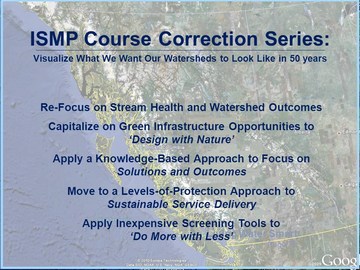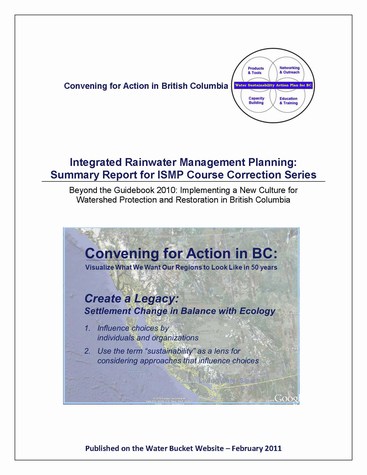Integrated Rainwater Management Planning: Summary Report for ISMP Course Correction Series
Note to Readers:
During the period November-December 2010, the Water Sustainability Action Plan for British Columbia released a 5-part series about considerations driving a course correction in the way ‘Integrated Stormwater Management Plans’ (ISMPs) are undertaken.

“As a result of collaborating on the series, the Partnership for Water Sustainability in British Columbia and Asset Management BC are aligning their efforts to achieve a shared goal: connect the dots between land use planning, watershed health AND infrastructure asset management,” states Kim Stephens, Executive Director of the Partnership.
“To guide those about to embark upon an ISMP process, we have released the Summary Report for ISMP Course Correction Series. It provides a consolidated reference source . The Summary Report is actually a compendium: a front-end plus all five documents in the ‘ISMP Course Correction Series’. The front-end is complete with a set of five recommendations.”
 What We Have Learned After a Decade
What We Have Learned After a Decade
 “A decade ago, local governments were venturing into uncharted waters when undertaking ISMPs. Now, the collective experience of the Bowker Creek Initiative (in the Capital Region), the City of Surrey and other pioneer leaders such as the District of North Vancouver serves as a guide for an approach that connects with the community and gets the watershed vision right,” states Ted van der Gulik, Chair of the Water Balance Model Partnership.
“A decade ago, local governments were venturing into uncharted waters when undertaking ISMPs. Now, the collective experience of the Bowker Creek Initiative (in the Capital Region), the City of Surrey and other pioneer leaders such as the District of North Vancouver serves as a guide for an approach that connects with the community and gets the watershed vision right,” states Ted van der Gulik, Chair of the Water Balance Model Partnership.
 “Outcome-oriented planning is a problem-solving PROCESS. It is not a procedure. It is not a matter of applying a regulation or a checklist. Participants have to be committed to the outcome,” adds Tim Pringle, President of the Partnership for Water Sustainability.
“Outcome-oriented planning is a problem-solving PROCESS. It is not a procedure. It is not a matter of applying a regulation or a checklist. Participants have to be committed to the outcome,” adds Tim Pringle, President of the Partnership for Water Sustainability.
Communities in Balance with Ecology
 “The genesis for ISMPs was a desire to integrate the community, engineering, planning and environmental perspectives. The implicit goal was to build and/or rebuild communities in balance with ecology. Local governments knew they had to do business differently in order to protect and/or restore watershed health,” states Robert Hicks, Senior Engineer in the Policy & Planning Division at Metro Vancouver. He has been involved in the ISMP process from the beginning.
“The genesis for ISMPs was a desire to integrate the community, engineering, planning and environmental perspectives. The implicit goal was to build and/or rebuild communities in balance with ecology. Local governments knew they had to do business differently in order to protect and/or restore watershed health,” states Robert Hicks, Senior Engineer in the Policy & Planning Division at Metro Vancouver. He has been involved in the ISMP process from the beginning.
 “Now, the ‘unfunded infrastructure liability’ is a driver for local governments to consider longevity, focus on what happens after developers hand-off municipal infrastructure, get it right at the front-end, and prepare for the future,” continues Glen Brown, Executive Director with the Ministry of Community, Sport and Cultural Development. His responsibilities encompass local government infrastructure and finance.
“Now, the ‘unfunded infrastructure liability’ is a driver for local governments to consider longevity, focus on what happens after developers hand-off municipal infrastructure, get it right at the front-end, and prepare for the future,” continues Glen Brown, Executive Director with the Ministry of Community, Sport and Cultural Development. His responsibilities encompass local government infrastructure and finance.
Sustainable Service Delivery
 “Tackling the unfunded infrastructure liability requires a life-cycle way of thinking about infrastructure needs, in particular how to pay for those needs over time. This holistic approach is described as Sustainable Service Delivery,” states Wally Wells, Coordinator for Asset Management BC.
“Tackling the unfunded infrastructure liability requires a life-cycle way of thinking about infrastructure needs, in particular how to pay for those needs over time. This holistic approach is described as Sustainable Service Delivery,” states Wally Wells, Coordinator for Asset Management BC.
 “The paradigm-shift starts with land use planning. Connecting the dots between watershed health and infrastructure type is emerging as an important piece in ‘sustainable drainage infrastructure’, both fiscally and ecologically,” emphasizes Kim Fowler, Director of Sustainability with the City of Victoria (and a member of the Local Government Asset Management Working Group).
“The paradigm-shift starts with land use planning. Connecting the dots between watershed health and infrastructure type is emerging as an important piece in ‘sustainable drainage infrastructure’, both fiscally and ecologically,” emphasizes Kim Fowler, Director of Sustainability with the City of Victoria (and a member of the Local Government Asset Management Working Group).
 “The financial burden and environmental impacts associated with ‘pipe-and-convey’ infrastructure contrast with the benefits of ‘green’ infrastructure at a watershed scale: natural landscape-based assets reduce runoff volumes, have lower life-cycle costs, decrease stresses applied to creeks, and enhance urban liveability,” continues Ray Fung, Chair of the Green Infrastructure Partnership.
“The financial burden and environmental impacts associated with ‘pipe-and-convey’ infrastructure contrast with the benefits of ‘green’ infrastructure at a watershed scale: natural landscape-based assets reduce runoff volumes, have lower life-cycle costs, decrease stresses applied to creeks, and enhance urban liveability,” continues Ray Fung, Chair of the Green Infrastructure Partnership.
 “Level-of-service is the integrator for everything that local governments do. Everyone will have to make level-of-service choices. Thus, a guiding principle for a watershed-based plan could be framed this way: Establish the level-of-service that is fiscally sustainable AND protects watershed health,” concludes John McMahon, Chair of Metro Vancouver’s Stormwater Interagency Liaison Group.
“Level-of-service is the integrator for everything that local governments do. Everyone will have to make level-of-service choices. Thus, a guiding principle for a watershed-based plan could be framed this way: Establish the level-of-service that is fiscally sustainable AND protects watershed health,” concludes John McMahon, Chair of Metro Vancouver’s Stormwater Interagency Liaison Group.
Regional Team Approach
“The expression ‘regional team approach’ is resonating in British Columbia. Team implies there is a personal commitment. The team approach enables local  governments to ‘do more with less’. This is accomplished through sharing of experiences, collaboration, alignment, and pooling of resources to get the job done. As applied to the ‘ISMP course correction’, a regional team approach would advance consistency regionally,” explains Richard Boase, Co-Chair of the Water Balance Model Partnership.
governments to ‘do more with less’. This is accomplished through sharing of experiences, collaboration, alignment, and pooling of resources to get the job done. As applied to the ‘ISMP course correction’, a regional team approach would advance consistency regionally,” explains Richard Boase, Co-Chair of the Water Balance Model Partnership.
Links for Downloading Documents
Click here to download the compendium – that is, Summary Report front-end PLUS the entire 5-part series.
To download a copy of the FRONT-END only, click here.
To access the 5-part series individually, click here

Posted February 2011

